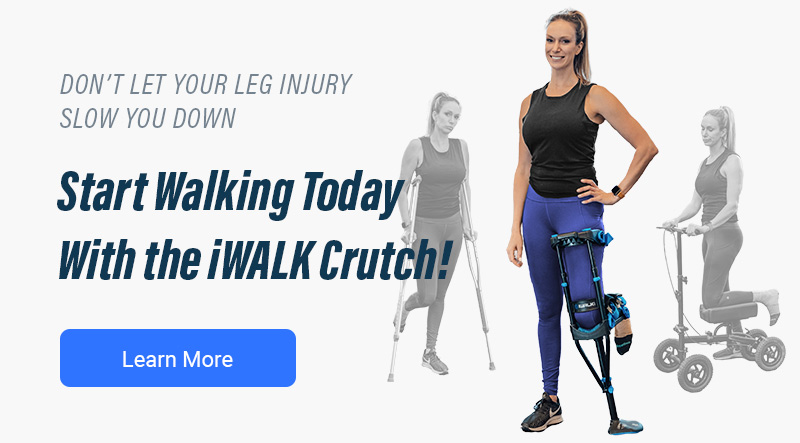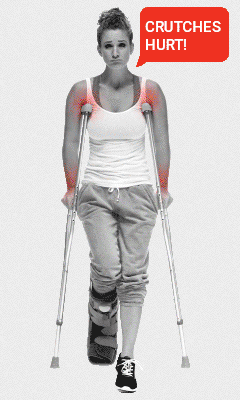Learn What Kinds of Crutch Bottoms Are Available, How to Fix Them, and How to Care For Your Crutches So You Can Get Back on Your Feet
Learning how to fix the bottom of crutches when they wear out or get damaged is another hurdle to overcome.
Thankfully, you can learn how to fix the bottom of your crutches right at home. Learn what kinds of crutch bottoms are available, how to fix them, and how to care for your crutches so you can get back on your feet.
What Do Crutch Bottoms Do?
When crutches are your only way to get around after an injury, you need them to perform. The small base on most crutches can turn a drop of water or the edge of a rug into a dangerous encounter. You can’t risk slipping or tripping and falling while you’re trying to recover, so finding good crutch bottoms can make all the difference.
A base with a good grip can help prevent slips and trips from water and other small objects in your path. A wider base makes it easier to move over rough or uneven ground. Some crutches—like the iWALK2.0 hands-free crutch—feature an all-terrain leg and foot design that keeps you stable on uneven and rough surfaces.
No matter what kind of crutch you use, good crutch bottoms are designed to help you stay safe and provide excellent grip and traction on the ground while you recover.
Different Types of Crutch Bottoms
While you’re probably familiar with traditional rubber crutch bottoms, there are other options and variations on this design. Some crutch bottoms offer more flexibility, making it easier to get around, while others feature special grips or tip attachments for when the weather turns sour.
Here are a few common types of crutch bottoms and their uses:
- Rubber Crutch Tips: Although all these crutch bottoms are made from the same material, they vary in shape and design. Some are more flexible and some offer rounded bottoms to help with ease of movement.
- Spikes: These come as crutch bottoms, but can also be purchased as temporary tips when you need to get around in snowy conditions. They have small spikes to give you more traction on slippery surfaces. Just make sure you take them off inside so you don’t damage your floors.
- All-Terrain Crutch Bottom: The iWALK2.0 features a unique, all-terrain crutch bottom that is designed to provide a stable base on both wet and dry surfaces.
- Quad-Point Support Tips: These tips are most commonly used with canes. They feature four points and provide greater stability for people with balance issues.
A good crutch bottom is what keeps you safe on your crutches. Make sure your crutch bottoms are in good repair and have a good grip to keep you safe.
How to Fix the Bottom of Crutches
If the bottom of your crutch gets damaged or is old and cracking, it’s time to replace them.
Worn out or damaged crutch bottoms won’t give you the grip or stability you need to safely get around while you’re recovering from an injury.
Thankfully..
Learning how to fix the bottom of crutches is a simple process you can do at home with some basic tools.
- To replace the crutch tip, you will need a flat head screwdriver and a sink with running water.
- To loosen the existing crutch tip, insert the flathead screwdriver in between the rubber and the metal leg of the crutch, widening the top of the crutch tip. Allow water to run into the crutch tip as you rotate the crutch, ensuring all sides of the crutch tip are loosened.
- Once you’re able to freely turn the crutch tip by hand, turn off the sink and pull the crutch-tip off of the crutch. This may require a little elbow grease on your part.
- Once you’ve removed the crutch tip, replace it with the new one. Put it on as tightly as you can by hand, then pound it on the floor a few times to make sure the metal of the crutch is securely inside the new crutch tip.
And just like that, you’ve learned how to fix the bottom of your crutches.
Where to Find Replacements
You can find basic crutch bottom replacements online at places like Amazon or at your local Walgreens, Walmart, or medical supply store.
If you have a more specialized crutch, contact the manufacturer to get a new crutch bottom or to get information on how to fix the bottom of your crutch. Some crutches have extremely resilient crutch bottoms such as the all-terrain crutch bottom of the iWALK2.0. A sturdy and stable crutch bottom not only lasts longer but also provides you with a stable and safe surface to walk on while you recover.
Durable Crutch Bottoms
The more durable your crutch bottom is, the less likely it is you will need to learn how to fix the bottom of your crutches.
Purchasing a good pair of crutches with a secure bottom will help keep you safe while you recover. The iWALK2.0 features a tread with a much greater surface area than a traditional crutch and offers more traction than conventional treads. The custom thread, designed by leading shoe and boot outsole manufacturer Vibram, offers durability, longevity, and safety to your crutch. There’s nothing else that compares.
Whatever type of crutch you choose, make sure your crutch bottoms keep you safe while you recover by providing sufficient traction on a variety of surfaces.
You Might Also Like:
Common Problems with Crutches and What to Do About Them
Common problems when using crutchs include shoulder, rib, and hand pain. Find out about how to deal with these issues, plus how to prevent sore armpits.
Crutch Substitute Proves Anything Is Possible
Many people assume that they won’t be able to go on vacation after an injury but that’s not always the case. Not only was Rip able to go on vacation with his family, he even managed to get some time on the slopes.










